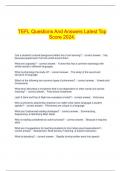TEFL Questions And Answers Latest Top
Score 2024.
Can a student's cultural background affect his or her learning? - correct answer. Yes,
because people learn from the world around them
What are cognates? - correct answer. A word that has a common etymology with
similar words in different languages
What is phonology the study of? - correct answer. The study of the sound and
structure of language
Which of the following are common types of phonemes? - correct answer. Vowels and
Consonants
What term describes a morpheme that is not dependent on other words and carries
meaning? - correct answer. Free lexical morpheme
Light & Dark and Day & Night are examples of what? - correct answer. Antonymy
Why is phonemic awareness important no matter what native language a student
speaks? - correct answer. Phonemes are unique to a language
What are 3 advanced reading strategies? - correct answer. Summarizing,
Sequencing, & Identifying Main Ideas
Why is reading considered an active process? - correct answer. Because it requires
effort
What are 3 suggestions for teaching students to form letter-sound associations? -
correct answer. Assessment, Multi-sensory Teaching, & Explicit Instruction
What is decoding? - correct answer. Rapidly turning written word into speech
,T/F: The first reading skill you should teach is how to compare and contrast. - correct
answer. False
Why is reading for purpose a higher level of thinking than comprehension? - correct
answer. B/c reading for purpose requires a comprehension of implicit ideas and
reading for purpose allows students to extend meaning
"Samuel ran to the store" is an pattern of what? - correct answer. S-V-O
"Myrtle drove to the store and Calvin bought a soda." is an example of what type of
sentence? - correct answer. Compound sentence
What is the word for the noun that a pronoun is replacing? - correct answer.
Antecedent
T/F- A verb always needs to have an object. - correct answer. False
T/F- In possessive nouns, possession is usually marked by an apostrophe (') - correct
answer. True
Which of the following is an important component of persuasive writing? - correct
answer. Thesis, Support, & Analysis
Alveolar ridge - correct answer. The gums just behind the upper teeth.
Palate - correct answer. The hard palate, or the roof of the mouth within the sphere of
your teeth.
Velum - correct answer. The soft palate, or the roof of your mouth as it extends past
the teeth, ending at the uvula.
Uvula - correct answer. The appendage that dangles in the back of your mouth before
your mouth turns into your throat
Pharynx - correct answer. The back of your throat, behind the uvula
Epiglottis - correct answer. A flap of flesh that rests below your pharynx, at the top of
your throat
Trachea - correct answer. The windpipe, which is covered by the epiglottis
Stops - correct answer. This is when you completely block the flow of air from your
throat by closing your mouth at some point during the pronunciation of the sound (p, t, k,
b, d, and g)
, Nasals - correct answer. In a nasal sound, you close your mouth just as you would
with a stop, but the back of your velum lowers, which allows air to flow up through your
nose and out of your nostrils (m, n,?).
Fricatives - correct answer. In this sound, you only close your mouth part way so air is
forced through a narrow passage, and makes a hissing sound (F, θ, v, s, z, ?, ?, h).
Affricates - correct answer. A combination of stop and fricative sounds that are made
in a similar way (tS, dZ)
Approximants - correct answer. This sound is like a fricative, except that it involves
less obstruction. Sometimes, you will make these sounds by touching the tip of your
tongue to the alveolar ridge, lowering it as you release the air (l, r, j, w)
voiced consonants - correct answer. consonant sounds that are accompanied by
vibrations in your throat as the air passes through
place of articulation - correct answer. Consonant sounds can also be classified based
on where in the vocal tract air gets obstructed
Bilabials - correct answer. When you close or constrict your lips
Labiodentals - correct answer. When your upper teeth and lower lip meet as you
speak
Dentals - correct answer. When you press the tip of your tongue to your upper teeth
as you speak
Alveolars - correct answer. When you press the tip of your tongue to the roof of your
mouth as you speak
Post-alveolars - correct answer. When you touch the tip of your tongue to your soft
palate when you speak
Palatals - correct answer. When the body of your tongue touches your palate as you
speak
Velars - correct answer. When the body of your tongue touches your velum as you
speak
Glottals - correct answer. When you constrict your glottis as you speak.
Vowel Sounds - correct answer. While vowel sounds still rely on the opening and
closing of the mouth, we block the airflow from our throat significantly less when
pronouncing them. Generally, different vowel sounds are made by different mouth
shapes and positions of the tongue body.




